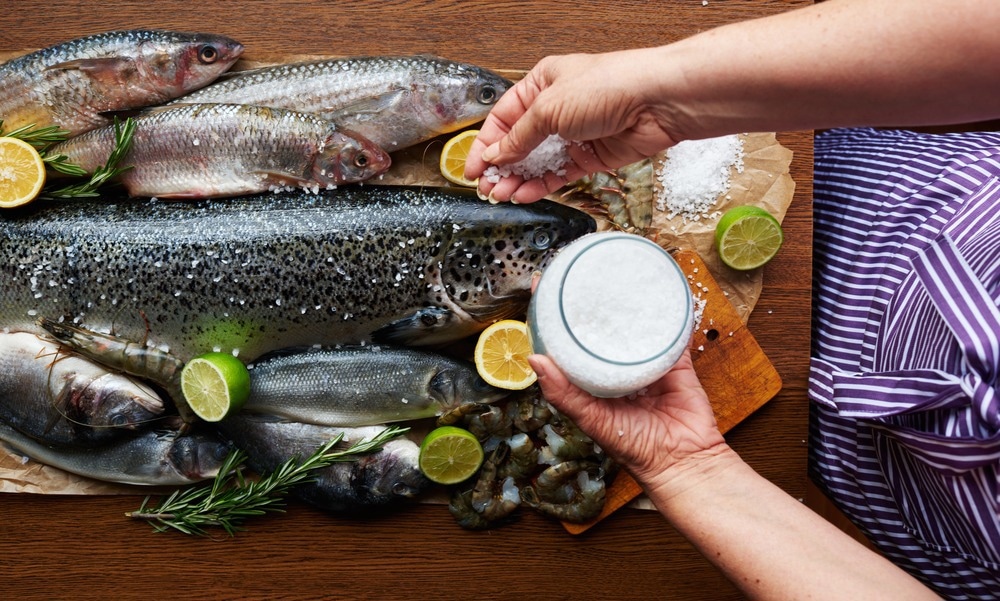In a recent study published in Environmental Research, researchers assess several probable biomarkers for self-documented lean fish, fatty fish, shellfish, and total seafood intake among pregnant female participants of the Nutritional Impact on the Immunological Maturation During Childhood in Relation to the Environment (NICE) study in Sweden.
 Study: Biomarkers of seafood intake during pregnancy – Pollutants versus fatty acids and micronutrients. Image Credit: ESstock / Shutterstock.com
Study: Biomarkers of seafood intake during pregnancy – Pollutants versus fatty acids and micronutrients. Image Credit: ESstock / Shutterstock.com
Background
Seafood is enriched with fatty acids, proteins, trace elements, and vitamins, the intake of which during pregnancy could improve infant development. Several studies have reported positive associations between daily fish intake during pregnancy and neonatal cognition and birth weight, which has also been inversely related to the development of eczema and food allergies among infants.
Seafood intake is usually determined by analyzing questionnaire data; however, questionnaire-based estimations may not be very reliable. The availability of reliable seafood diet biomarkers could also improve the accuracy of measuring intake measures and, as a result, research quality.
Importantly, seafood might comprise environment-polluting substances such as arsenic and methylmercury. However, data on methylmercury as a seafood intake biomarker are limited.
About the study
In the present study, researchers assess several probable seafood intake biomarkers, including selenium, long-chain omega 3 fatty acids (n-3 LCPUFAs), methylmercury, iodine, and various compounds of arsenic among 549 pregnant NICE study participants at 29 weeks gestation.
Docosahexaenoic acid (DHA), docosapentaenoic acid (DPA), eicosapentaenoic acid (EPA), selenium, methylmercury, iodine, trimethylarsine oxide, arsenocholine, arsenobetaine, total arsenic, inorganic-type metabolites, or arsenic levels were measured in urine and serum.
EPA, DPA, and DHA proportions in red blood cells (RBCs) were determined using gas chromatography. Inductively coupled plasma mass spectrometry (ICP-MS) was used to determine selenium levels in serum and RBCs, arsenic and mercury levels in RBCs, as well as various arsenic-containing substances and iodine in urine.
Arsenic-comprising substances were separated by ion exchange involving high-performance liquid chromatography (HPLC). Biomarker data were obtained using food consumption questionnaires that were completed by the participants at gestational week 34.
Biomarker levels were correlated with total seafood intake and that of lean fish, shellfish, and fatty acid individually in the final trimester. Pregnant females were recruited between 2015 and 2018 from the Sunderby Hospital located in the Norrbotten county of Sweden while undergoing regular sonography at gestational weeks 18 and 19.
Only Norbotten county residents who could write and speak Swedish and were to deliver in the Sunderby hospital were included in the analysis. The initial urine and blood samples were obtained in week 29 of pregnancy. Data on anthropometric and background variables were retrieved from the birth records.
Results
A total of 655 women were recruited and after excluding 18 women with second pregnancies, three women who delivered twins, and one woman who withdrew before study completion, 633 women were eligible.
However, 599 women ultimately provided serum and urine samples, and seafood intake data was valid for 554 women. The median values for participant age and seafood intake in late pregnancy were 30.5 years and 26 grams/day, respectively.
The median intake of fatty fish, shellfish, and lean fish was 9.1, 4.1, and 6.6 grams/day, respectively. Among the participants, 55% consumed seafood once or twice weekly, whereas the intake of fatty fish, shellfish, and lean fish was one to three times monthly among 44%, 47%, and 48%, respectively.
Only four of the participants reported no seafood intake during the final months of pregnancy. Freshwater Salmonids like brown trouts were consumed more than one time each month by 23% and 11% of participants before and during pregnancy, respectively.
The corresponding percentages for freshwater predator-type fish, including perch and northern, were 10% and 3%, respectively, whereas these percentages for brackish water fish, including Baltic herring, were 21% and 12%, respectively.
Iodine levels in urine were 54% greater among women who regularly consumed multivitamins with minerals.RBC and serological selenium levels were also greater among those consuming multivitamin supplements at 5% and 13%, respectively.
For women who consumed multivitamins with minerals daily, the total arsenic and arsenobetaine concentrations in urine were 65% and 108% higher, respectively. The median amount of seafood consumed by the participants was 184 grams weekly.
Daily seafood intake showed the most robust correlations with RBC mercury concentrations, comprising mainly methylmercury, total arsenic content in RBCs, and arsenobetaine in urine.
The biomarker substances showed positive correlations with the consumption of shellfish, fatty fish, and lean fish. RBC DHA and serological selenium levels showed correlations, albeit weak, with mainly fatty fish.
Among n-3 LCPUFA in RBCs, docosahexaenoic acid showed the greatest abundance during pregnancy, with lower levels of docosapentaenoic acid and eicosapentaenoic acid. Pregnant females consuming high amounts of seafood had significantly greater levels of the biomarkers, with the exception of docosapentaenoic acid levels in RBCs and iodine levels in urine. In the urine of women with high seafood intake, arsenobetaine, and trimethylarsine oxide were 2.5-fold and 3.5-fold greater, respectively.
Conclusions
Overall, the study findings showed that the mercury content in RBCs and arsenobetaine in urine could be considered seafood consumption biomarkers, as they correlated more strongly as compared to long-chain omega-3 fatty acid levels. However, the biomarkers’ relevance might differ by the seafood type and amount consumed.
Journal reference:
- Stråvik, M., Gustin, K., Barman, M., et al. (2023). Biomarkers of seafood intake during pregnancy – Pollutants versus fatty acids and micronutrients. Environmental Research. doi:10.1016/ j.envres.2023.115576.

 PARENTING TIPS
PARENTING TIPS







 PREGNANCY
PREGNANCY








 BABY CARE
BABY CARE








 TODDLERS
TODDLERS








 TEENS
TEENS








 HEALTH CARE
HEALTH CARE






 ACTIVITIES & CRAFTS
ACTIVITIES & CRAFTS








 CONTACT
CONTACT ABOUT
ABOUT

